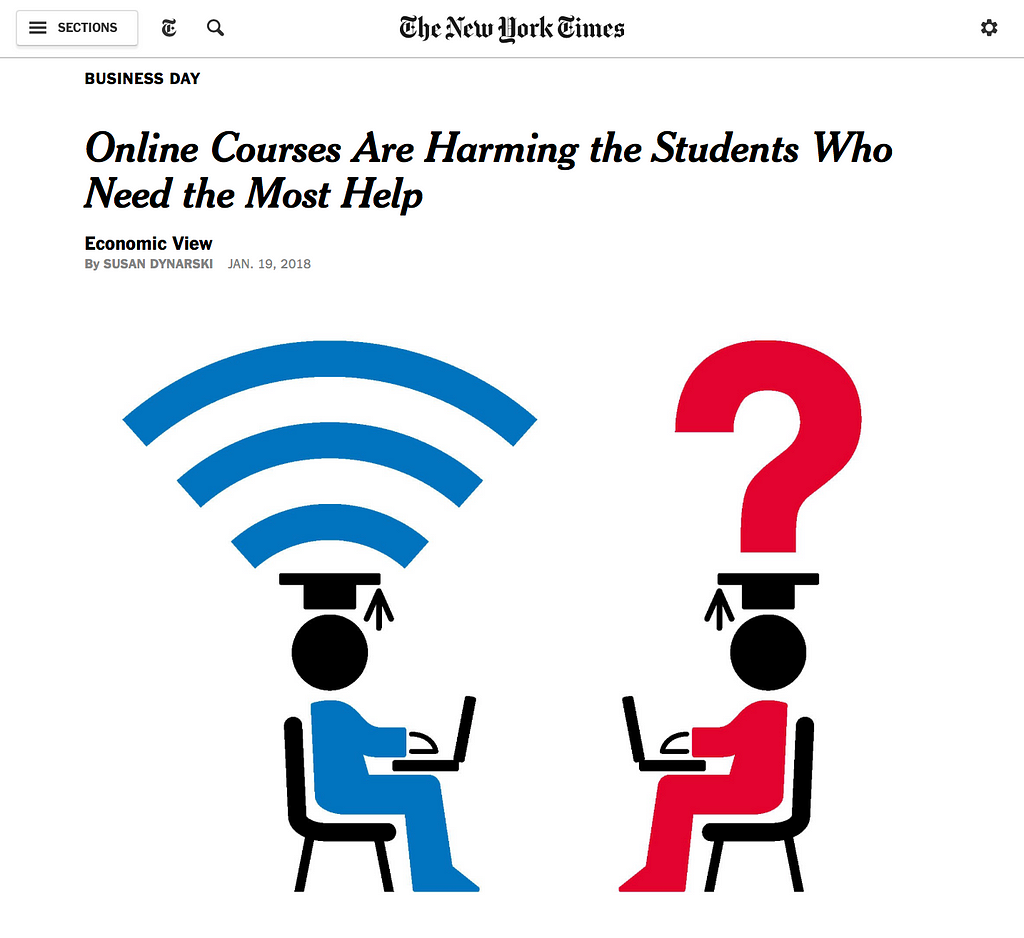Latest news about Bitcoin and all cryptocurrencies. Your daily crypto news habit.
 Image via The New York TimesBrought to you ODEM
Image via The New York TimesBrought to you ODEM
The darker side of online education is becoming more apparent.
That was my takeaway from a recent Economic View column in the New York Times by University of Michigan Professor Susan Dynarski.
In Online Courses Are Harming the Students Who Need the Most Help, Dynarski points to disturbing signs that the spread of online education is hurting weaker students who are more likely to benefit from live, in-person instruction.
While online courses have some significant benefits and hold the promise of reaching vast numbers of students, evidence suggests their widespread use is problematic for less proficient students and contribute to a widening of the knowledge gap between students who are succeeding at school and those who are not.
With a fully online course, “A student may never be in the same room with an instructor,” Dynarski writes. “[This] is where less proficient students tend to run into trouble. After all, taking a class without a teacher requires high levels of self-motivation, self-regulation and organization. Yet in high schools across the country, students who are struggling in traditional classrooms are increasingly steered into online courses.”
Last year, scholars at Harvard University and Stanford University published research on the academic performance of hundreds of thousands of students at DeVry University, a for-profit college with classes across America.
“DeVry offers online and face-to-face versions of all its courses, using the same textbooks, assessments, assignments and lecture materials in each format,” Dynarski wrote. “Even though the courses are seemingly identical, the students who enroll online do substantially worse.”
“The effects are lasting, with online students more likely to drop out of college altogether,” said Dynarski. “Hardest hit are those who entered the online class with low grades. Work by researchers in many other colleges concurs with the DeVry findings: The weakest students are hurt most by the online format.”
While Dynarski assessed high school and college students’ engagement in online courses, the results are relevant to people of all ages who are seeking to upgrade their skills and improve their career opportunities.
At ODEM.IO and our partner, Excelorators Inc., we’re passionate about the power of inclusive, on-site learning and increased student interaction with live teachers and professors. We believe education best takes place through face-to-face, live contact. Our blockchain-based platform empowers students and educators to collaborate on the development and delivery of high-quality educational experiences.
And, as educators learn more about the strengths and weakness of online learning, we hope that students of all ability levels will be able to see the light.
Rich
ODEM CEO
Join the ODEM conversation on Telegram ahead of our Feb. 17 crowdsale.The ODEM platform, our sponsor, reduces costs and improves access to premium education by directly connecting educators with students and eliminating inefficient-and-costly intermediaries. Join the Education Revolution.
Online Education Leaves Too Many Students Behind was originally published in Hacker Noon on Medium, where people are continuing the conversation by highlighting and responding to this story.
Disclaimer
The views and opinions expressed in this article are solely those of the authors and do not reflect the views of Bitcoin Insider. Every investment and trading move involves risk - this is especially true for cryptocurrencies given their volatility. We strongly advise our readers to conduct their own research when making a decision.